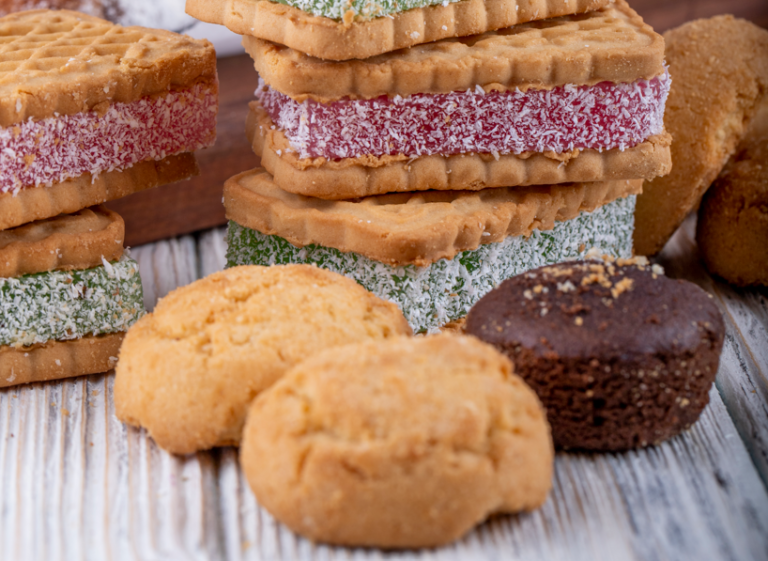Welcome to the delightful world of three types of brownies: fudgy, cakey, and chewy. Whether you’re a baking enthusiast or simply a lover of all things chocolate, this guide will help you understand the distinct characteristics of each type and how to bake them perfectly.
Unpacking the Secrets of Cakey Brownies Within the Three Types of Brownies
Steps to Perfect the Light Texture of Cakey Brownies
Detail the unique methods required to achieve the airy, cake-like texture that characterizes cakey brownies.
Characteristics and Ingredients
For those who prefer a lighter, airier texture, cakey brownies fit the bill perfectly. What sets them apart? It’s all in the flour and the inclusion of baking powder, which helps these brownies rise and achieve a fluffier consistency. Unlike their fudgy counterparts, cakey brownies lean on a bit more flour and less fat, striking a balance that results in a tender, cake-like texture.
Baking Techniques
Precision is paramount when baking cakey brownies. Creaming the butter with sugar until fluffy introduces air into the mix, which helps achieve that characteristic light texture. Make sure to sift the dry ingredients to avoid any lumps and ensure even distribution throughout the batter. And unlike fudgy brownies, a bit more mixing is required to help them rise properly—just be careful not to overdo it!
Unique Combinations
Cakey brownies serve as a wonderful canvas for various flavor infusions. Adding fresh lemon zest or a dash of cinnamon can brighten the batter, offering a refreshing twist to the traditional chocolate. For those with adventurous palates, consider mixing in coconut flakes or almond pieces for added texture and flavor complexity. These ingredients not only enhance the taste but also complement the lighter texture of cakey brownies beautifully.
Next up, we’ll dive into the world of chewy brownies, exploring the perfect balance between dense fudgy, and light cakey textures. Stay tuned to master yet another delicious brownie style!
Chewy Brownies: Perfecting a Favorite Among the Three Types of Brownies
Key Ingredients and Mixing Techniques for Chewy Brownies
Explain the balance of ingredients and mixing methods that are essential for creating the desirable chewy texture in brownies.
Characteristics and Ingredients
Chewy brownies strike a delightful balance in the brownie world. They are not as dense as fudgy brownies, nor as light as cakey ones; they’re just right. What’s their secret? The magic lies in the use of both butter and a touch of oil, which imparts that chewy texture everyone loves. Moreover, incorporating brown sugar adds moisture and a rich, caramel-like flavor that complements the chocolate beautifully.
Healthier Options
If you’re looking to tweak the traditional chewy brownie recipe for a healthier alternative, consider substituting some of the white sugar with coconut sugar or using whole wheat flour instead of all-purpose flour. These swaps can help lower the glycemic index and add nutritional value without compromising the beloved chewy texture.
Tips for Perfect Chewy Brownies
For that perfect chewy bite, it’s crucial to get the baking time just right—overbaking is the enemy here. Keep an eye on your oven and start checking for doneness a few minutes before the recipe suggests. Brownies continue to cook a bit as they cool, so pulling them out of the oven when they’re barely set allows them to achieve that coveted chewy texture. Also, let them cool completely in the pan to help them set properly.
As we continue, we’ll explore essential baking tools that can make or break your brownie baking success. These tools ensure your brownies come out perfect every time, whether they’re fudgy, cakey, or chewy. Stay tuned for these must-have kitchen gadgets!
Essential Baking Tools for Brownies
Whether you prefer fudgy, cakey, or chewy brownies, this section provides tips on how to add flavors and textures that complement each of the three types of brownies, from nuts and caramel to fruit and spices.
Choosing the Right Bakeware
The choice of baking pan can significantly affect the outcome of your brownies. Metal pans are ideal for achieving crisp edges and an evenly cooked center, crucial for both fudgy and chewy brownies. On the other hand, glass or ceramic pans might require a longer baking time, affecting the texture. Always ensure to line your pan with parchment paper or lightly grease it to prevent sticking and to achieve flawless removal.
Accuracy in Measurement
Precision is key in baking. For consistent results, it’s advisable to use a digital kitchen scale. This tool ensures that ingredients are measured accurately, which is especially important for the delicate balance required in brownie recipes. Measuring cups can vary, but a scale provides certainty that each batch of brownies will have the same perfect texture and taste.
Monitoring Baking Temperature
An often-overlooked tool is the oven thermometer. Ovens can sometimes run hotter or cooler than the settings indicate. By using an oven thermometer, you can ensure your brownies are baking at the correct temperature, preventing overbaking or underbaking. This simple tool can be a game-changer, especially when striving for the perfect gooeyness in fudgy brownies or the tender crumb of cakey brownies.
With the right tools in hand, you’re set to tackle any brownie recipe with confidence. Next, we’ll explore advanced baking tips and troubleshooting to help you perfect your brownie-making skills. Stay tuned!
Advanced Baking Tips and Troubleshooting
Achieving the Perfect Crust and Texture
One of the hallmarks of a great brownie is its crust. To achieve that crinkly top on your brownies, the key is in the beating of eggs and sugar. Whip them together until the mixture is pale and fluffy—this process helps to create a meringue-like top during baking, which gives you that desirable texture. Additionally, make sure your batter has the right consistency before pouring it into the pan; it should be thick but pourable.
Troubleshooting Common Brownie Baking Issues
Even the most experienced bakers run into problems now and then. If your brownies came out too dry, consider adding a bit more fat, like butter or oil, in your next batch. Conversely, if they’re too wet, slightly increase the flour or baking time in small increments. Remember, different ovens may require adjustments to the recommended baking times.
If you’re finding that your brownies aren’t baking evenly, make sure to rotate the pan halfway through cooking time. This ensures all sides get equal heat exposure. Additionally, if the edges cook faster than the center, you can cover them with strips of aluminum foil midway through baking to prevent them from burning.
By understanding these nuances and knowing how to adjust, you can ensure your brownies will turn out just as you want them every time. Now that we’ve covered some advanced tips and troubleshooting techniques, next up, we’ll delve into the most frequently asked questions about brownies, providing answers that can help you refine your baking skills even further. Stay tuned for valuable insights that will address common curiosities and concerns in the world of brownie baking!
Frosting and Toppings for Brownies
Choosing the Right Frosting
A great frosting can elevate your brownies to a whole new level of indulgence. For a classic choice, buttercream frosting melds beautifully with both cakey and fudgy brownies, providing a smooth and creamy top layer. If you’re a fan of richer flavors, chocolate ganache is a decadent option that hardens slightly to create a glossy finish.
Creative Toppings
Beyond frosting, there are numerous toppings that can add texture and flavor to your brownies. Sprinkling sea salt lightly over chocolate ganache can enhance the chocolate’s depth. For a nutty crunch, toasted pecans or walnuts are excellent choices. If you prefer a fruity flavor, try scattering fresh raspberries or drizzled raspberry sauce over the top.
Themed Variations for Special Occasions
With the right frosting and creative toppings, your brownies will not only taste delicious but also look stunning. Whether you’re baking for a special occasion or just a casual treat, these finishing touches will make your brownies a hit with anyone lucky enough to try them. Enjoy the process of experimenting with different combinations to find your perfect match!
Ideal Pairings and Occasions for Each Style of Brownie
Beverage Pairings
Finding the right drink to accompany your brownies can enhance the eating experience. For fudgy brownies, a glass of cold milk is a classic choice, as its creaminess complements the intense chocolate flavor. Chewy brownies, with their balanced texture, pair wonderfully with a cup of strong coffee, which cuts through the sweetness and highlights the deeper chocolate notes. For cakey brownies, try a light, sweet dessert wine that echoes their delicate flavor without overpowering it.
Occasions for Brownies
Brownies are versatile enough to fit any event or gathering. For casual get-togethers, chewy brownies are a crowd-pleaser with their familiar texture and rich taste. Cakey brownies, with their lighter, airy texture, are perfect for high tea or as an after-dinner dessert that won’t feel too heavy. Fudgy brownies, being the richest of the three, are ideal for more decadent celebrations like birthday parties or family holidays where indulgence is key.
Customizing Brownies for Special Diets
With dietary needs varying from person to person, it’s helpful to have variations ready for those who follow specific eating patterns. Gluten-free brownies can be made using almond flour or a gluten-free baking mix to cater to those with gluten intolerances. For vegan guests, swap out dairy and eggs with alternatives like coconut oil and flax eggs to make any brownie type vegan-friendly.
By considering these pairings and occasion-specific types, you can tailor your brownie baking to perfectly suit any event, ensuring each guest enjoys a treat that feels specially thought out for them.
Common Baking Mistakes and How to Avoid Them
In baking the three types of brownies, mistakes can happen. This part offers solutions and preventive tips to ensure your brownies turn out perfectly every time.
Conclusion
Now that you’ve learned about the three types of brownies and how to make them, it’s time to preheat your oven and start baking. Whether you choose fudgy, cakey, or chewy, each type offers unique pleasures that are sure to satisfy any chocolate lover.
By revising your article to include the keyphrase “three types of brownies” more consistently, you can improve its SEO performance without compromising the natural flow of the content.

